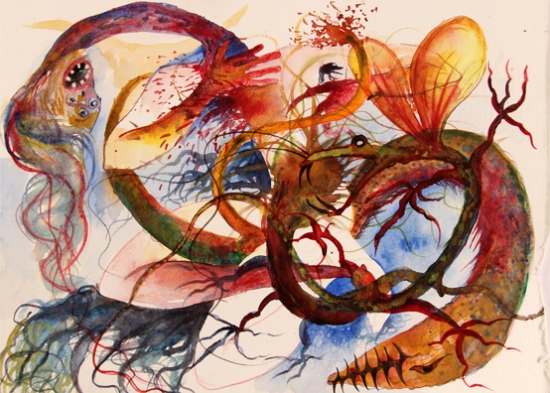by Words without Borders, New York, April 2015

Image: Priyantha Udagedara, “Super Hybrid V,” Watercolor on Paper, 30x38cm, 2013
This month we present Tamil writing. The Tamil literary tradition of associating images with landscapes informs the fiction and poetry here, as writers locate their considerations of alienation, exile, and diaspora, and address how identities and customs change with both figurative and literal terrain. In tales from two masters, Sundara Ramaswamy’s retired bureaucrat bristles at a young man’s perceived slight, and Ashokamitran evokes Borges, Emily Dickinson, and Ambrose Bierce. The old collides with the new as Sukumaran and Kutti Revathi investigate cross-caste marriages, Appudurai Muttalingam finds a traditional community torn apart by war, and Imayam shows the true chasm between a distant son and his plaintive mother. Che Guevara turns up in both Dhamayanti’s look at a charismatic revolutionary and Perundevi’s challenge to a divinity. Dilip Kumar’s sly fable depicts an unlikely duel. In poetry from Sri Lanka, Aazhiyaal’s transposition of myth reverberates with the horrors of the long ethnic war, Thirumavalavan writes from a jarring snowscape, Malathi Maitri considers the exile’s endless road, Sharmila Sayeed moves between Sri Lanka and India, and Krishangini confronts free-floating terror. We thank our guest editor, Lakshmi Holmström, as well as Subashree Krishnaswamy for her assistance with the texts.
Introduction in full below.
by Lakshmi Holstrom,
 Early Tamil literary theory and poetics, from around the beginning of the Christian era, classified the subject matter of all literature into two main genres, akam and puram. Akam refers to the inner world, and is, effectively, to do with love. Puram refers to the outer world and consists of the praise of kings and patrons, and about war and the death of warriors. Both akam and puram are further divided into five main types, each associated with a particular landscape, tinai, and a system of images associated with that landscape.
Early Tamil literary theory and poetics, from around the beginning of the Christian era, classified the subject matter of all literature into two main genres, akam and puram. Akam refers to the inner world, and is, effectively, to do with love. Puram refers to the outer world and consists of the praise of kings and patrons, and about war and the death of warriors. Both akam and puram are further divided into five main types, each associated with a particular landscape, tinai, and a system of images associated with that landscape.
The poetics of landscape continues to haunt Tamil writing. Of course, modern writers don’t seek to replicate it, but rather, to glance at it, allude to it, dialogue with it, or even reconfigure it. That is the exciting bit. So we get in their writing cityscapes of alienation, snowscapes of exile and diaspora, landscapes of the imagination, fantasy worlds. But we also get confrontations and collisions between these different perspectives and worldviews; between the old and the new. So changing landscapes are also about changing identities.
The Tamil word for identity is adaiyaalam. The original sense of the word is “mark,” or a means of identification (of a person, by others). The modern sense of “identity,” and the shift in meaning is apparent in new compounds, e.g. suya adaiyaalam, self-identity, tamizh adaiyaalam, Tamil identity, and adaiyaala arasiyal, identity politics. The idea of change and changing identities is linked with some national movements such as the Progressive Writers’ movement, or the struggle for women’s rights and caste equality, but they are shaped also by local and regional forms of political expression such as the anti-Brahmin Self Respect movement led by Periyar in the 1930s.
Perhaps the greatest change impacting on the idea of “Tamil identity” is the formation of an international Tamil diaspora in the past three decades or so. This has happened for many reasons, but particularly because of the departure of Sri Lankan Tamils during the years of civil war. An untitled poem written in 2009 by the poet Cheran, who now lives in Canada, reads,
The sea has drained away
Tamil has no territory
Kinships have no name.
Cheran (2013:127)
Detached from any one land, the modern Tamil identity is very often a hyphenated one, and one that is linked to a fiction that has travelled or is travelling. Words without borders, indeed.
In modern Tamil writing, the short story is above all the genre in which these themes are played out. It is the genre that has been most amenable to experimentation, since the 1930s. In this collection, we have showcased poetry and short fiction by established writers, and some by less well-known ones. There will, of course, be some surprises. As we selected our stories, we were fascinated by the way themes overlapped and threaded through them.
The oldest writers represented here are Sundara Ramaswamy and Ashokamitran. Ramaswamy, who died eleven years ago, was one of the most versatile writers of our times, a novelist, short story writer, poet, and critic, while Ashokamitran has been a prolific writer of short stories and novellas. Both these writers, as well as Dilip Kumar (“A Mousy, Measly Tale”), are characterized by their use of irony. In their stories chosen here there is a dissonance, a jarring between how we see ourselves, and how others see us; between the fantasy and the real.
Sukumaran (“Ayya’s Bicycle,” 2014) and Kutti Revathi (“A Mansion with Many Rooms,” 2014) are known in the first instance as poets; they have only recently turned to short fiction. Both their stories deal with an older world based on caste hierarchy that jostles against a new order based on social mobility and merit. But Sukumaran’s story is also about the way different generations imagine the world, a theme vividly present in Imayam, whose “Truth and Lies” (2008) is about the obligations and dependencies still present in the village community that an elderly mother holds dear but which are rejected by her son, who favors urban values.
Like Kutti Revathi, Salma is best known as a poet, but she has also published a novel, and more recently, a collection of short stories. She writes from the perspective of a Muslim woman and continually examines the ways in which women find ways to break free from a world of patriarchal control.
Appadurai Muttulingam, one of the finest of short story writers from Sri Lanka, now lives in Toronto. His story, “Horoscopes,” juxtaposes a tight little community held together by a set of customs, rituals, and superstitions with a scattered, worldwide diaspora. Of course, it is the coming of the ethnic war that ends that world.
The three decades of ethnic war, those years of continuous suffering and loss, shadow all Sri Lankan writing in Tamil, and are most vividly present in the poetry. The poems we have chosen for this issue are all by women, except for one, Thirumavalavan (“Ploughing the Fields of Snow”), a Sri Lankan who now lives in Toronto. Sharmila Seyyid (“Three Dreams”) moves between Sri Lanka and India. Aazhiyaal (“The Mother and the Goddess of Night”) is of Sri Lankan origin, now living in Australia. Aazhiyaal’s startling transposition of the Persephone myth gains a particular poignancy in view of the many women searching for lost and “disappeared”daughters (and other members of their families) in the aftermath of the war.
The recent Sri Lankan war poetry has had a huge impact on all modern Tamil writing. But the other notable development in Tamil is the poetry by women, both from Sri Lanka and Tamil-speaking India. In the best of this poetry, there is an equal political sharpness. For example, Perundevi’s poem, which questions the status of Rama, has to be read in the light of the resurgence of a certain kind of fundamentalism in India.
Modern Tamil writing comes from surprising places, and is surprisingly diverse. Yet, as our stories show, there are common themes, shared memories and shared histories. The past is not lost in them, there is indeed the shadow of loss, but there is also the intense stimulus of what is new and yet to come.